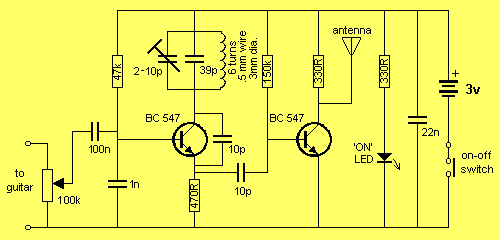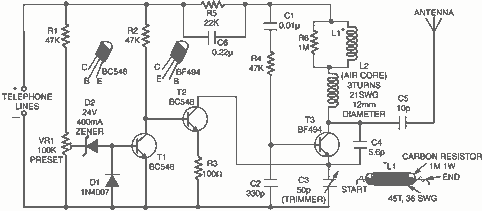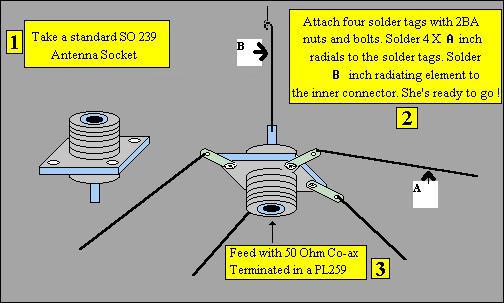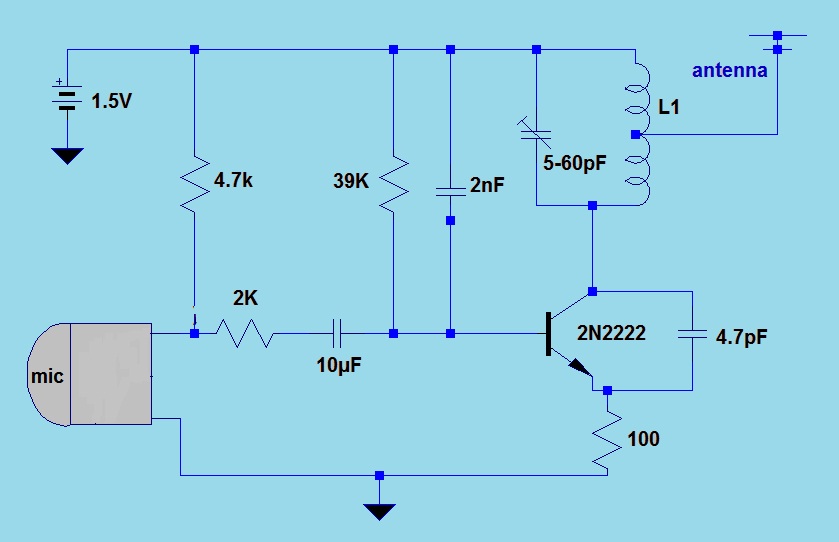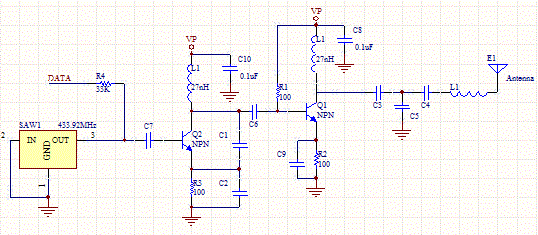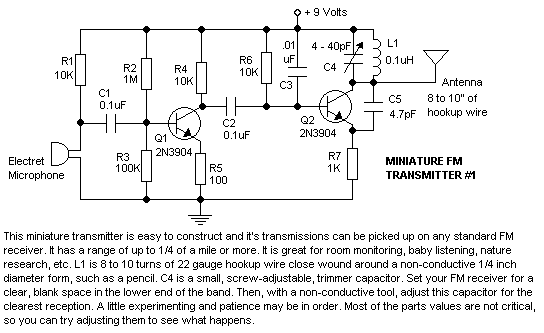
14W CW TRANSMITTER
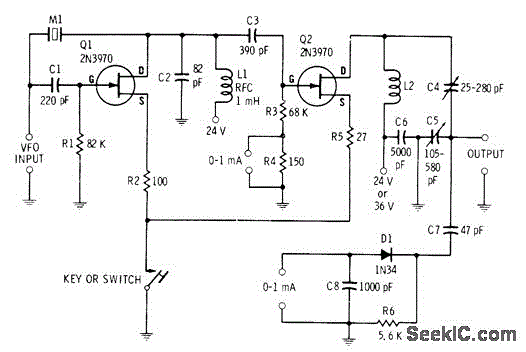
A low-power two-stage FET transmitter designed for the 80-meter amateur band utilizes a Pierce crystal oscillator that does not require an output resonant circuit. A DC milliammeter can be connected across a 150-ohm resistor in the gate circuit of the second transistor to indicate the strength of the oscillator output signal. The resonant circuit of the RF amplifier Q2 employs a toroidal inductor L2, consisting of 56 turns of No. 24 enamel wire wound on a 13/16-inch core.
The described circuit is an efficient low-power transmitter suitable for operation within the 80-meter amateur radio band. The Pierce crystal oscillator serves as the frequency-determining element, providing stable oscillation without the need for additional resonant components, which simplifies the design and minimizes the overall footprint of the transmitter. This oscillator configuration is known for its low phase noise and good frequency stability, making it ideal for amateur radio applications.
In the circuit, the second transistor acts as an RF amplifier, amplifying the signal generated by the oscillator. The use of a 150-ohm resistor in the gate circuit allows for the measurement of the output signal strength, providing valuable feedback for tuning and optimizing the transmitter's performance. The inclusion of a DC milliammeter gives the operator a direct indication of the oscillator's output level, facilitating adjustments to achieve the desired transmission strength.
The resonant circuit of the RF amplifier Q2 is critical for ensuring efficient signal amplification. The toroidal inductor L2, with its 56 turns of No. 24 enamel wire, is designed to provide the necessary inductance while maintaining a compact size. The choice of a toroidal core helps to minimize electromagnetic interference and improve the overall efficiency of the circuit. This design approach not only enhances the transmitter's performance but also contributes to its reliability and longevity in operation.
Overall, this low-power FET transmitter is a well-engineered solution for amateur radio enthusiasts, combining simplicity, efficiency, and effective signal amplification to meet the demands of the 80-meter band.Low-power two-stage FET transmitter for 80-meter amateur band uses Pierce crystal oscillator that requires no output resonant ci.rcuit. DC milliammeter can be connected across 150-ohm resistor in gate circuit of second transistor to indicate strength of oscillator output signal, Resonant circuit of RF amplifier Q2 uses toroid L2 (56turns No, 24 enamel 13/16-..
🔗 External reference
The described circuit is an efficient low-power transmitter suitable for operation within the 80-meter amateur radio band. The Pierce crystal oscillator serves as the frequency-determining element, providing stable oscillation without the need for additional resonant components, which simplifies the design and minimizes the overall footprint of the transmitter. This oscillator configuration is known for its low phase noise and good frequency stability, making it ideal for amateur radio applications.
In the circuit, the second transistor acts as an RF amplifier, amplifying the signal generated by the oscillator. The use of a 150-ohm resistor in the gate circuit allows for the measurement of the output signal strength, providing valuable feedback for tuning and optimizing the transmitter's performance. The inclusion of a DC milliammeter gives the operator a direct indication of the oscillator's output level, facilitating adjustments to achieve the desired transmission strength.
The resonant circuit of the RF amplifier Q2 is critical for ensuring efficient signal amplification. The toroidal inductor L2, with its 56 turns of No. 24 enamel wire, is designed to provide the necessary inductance while maintaining a compact size. The choice of a toroidal core helps to minimize electromagnetic interference and improve the overall efficiency of the circuit. This design approach not only enhances the transmitter's performance but also contributes to its reliability and longevity in operation.
Overall, this low-power FET transmitter is a well-engineered solution for amateur radio enthusiasts, combining simplicity, efficiency, and effective signal amplification to meet the demands of the 80-meter band.Low-power two-stage FET transmitter for 80-meter amateur band uses Pierce crystal oscillator that requires no output resonant ci.rcuit. DC milliammeter can be connected across 150-ohm resistor in gate circuit of second transistor to indicate strength of oscillator output signal, Resonant circuit of RF amplifier Q2 uses toroid L2 (56turns No, 24 enamel 13/16-..
🔗 External reference
